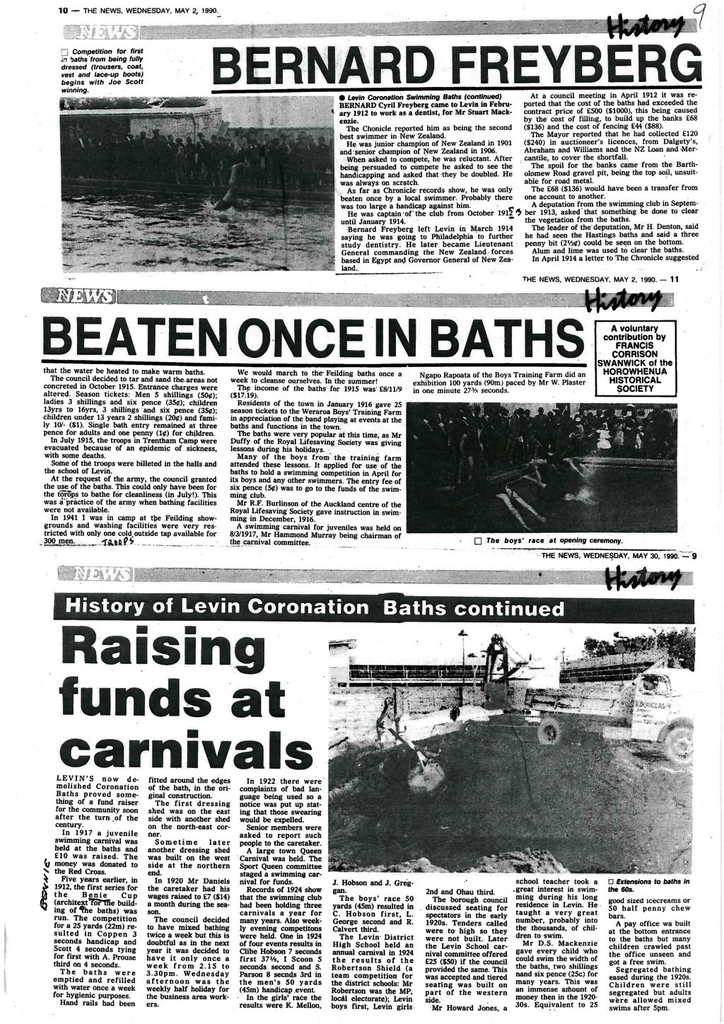History of the Levin Coronation Baths
- Description
This text that follows is the content of the attached PDF.
Bernard Cyril Freyberg came to Levin in February 1912 to work as a dentist, for Mr Stuart MacKenzie.
The Chronicle reported him as being the second best swimmer in New Zealand. He was junior champion of New Zealand in 1901 and senior champion of New Zealand in 1906.
When asked to compete, he was reluctant. After being persuaded to compete he asked to see the handicapping and asked that they be doubled. He was always on scratch.
As far as Chronicle records show, he was only beaten once by a local swimmer. Probably there was too large a handicap against him. He was captain of the club from October 1913 until January 1914.
Photo at left: Competition for first in baths from being fully dressed (trousers, coat, vest and lace-up shoes) begins with Joe Scott winning.
Photo at right shows the boys' race at opening ceremony.
Bernard Freyberg left Levin in March 1914 saying he was going to Philadelphia to further study dentistry. He later became Lieutenant General commanding the New Zealand forces based in Egypt and Governor General of New Zealand.
At a council meeting in April 1912 it was reported that the cost of the baths had exceeded the contract price of £500 ($1000), this being caused by the cost of filling, to build up the banks £68 ($136) and the cost of fencing £44 ($88).
The Mayor reported that he had collected £120 ($240) in auctioneer’s licences, from Dalgety’s, Abraham and Williams and the NZ Loan and Mercantile, to cover the shortfall.
The spoil for the banks came from the Bartholomew Road gravel pit, being the top soil, unsuitable for road metal.
The £68 ($136) would have been a transfer from one account to another.
A deputation from the swimming club in September 1913, asked that something be done to clear the vegetation from the baths.
The leader of the deputation, Mr. H. Denton said he had seen the Hastings baths and said a three penny bit (2½c) could be seen on the bottom. Alum and lime was used to clear the baths.
In April 1914 a letter to the Chronicle suggested that the water be heated to make warm baths.
The council decided to tar and sand the areas not concreted in October 1915. Entrance charges were altered. Season tickets: Men 5 shillings (50c); ladies 3 shillings and six pence (35c); children under 13 years 2 shillings (20c) and family 10/- ($1). Single bath entry remained at three pence (3c) for adults and one penny (1c) for children.
In July 1915, the troops in Trentham Camp were evacuated because of an epidemic of sickness, with some deaths.
Some of the troops were billeted in the halls and the school of Levin.
At the request of the army, the council granted the use of the baths. This could only have been for the troops to bathe for cleanliness (in July !). This was a practice of the army when bathing facilities were not available.
In 1941, I was in camp at the Feilding showgrounds and washing facilities were very restricted with only one cold outside tap available for 300 men.
We would march to the Feilding baths once a week to cleanse ourselves. In the summer!
The income of the baths for 1915 was £8/11/9 ($17.19).
Residents of the town in January 1916 gave 25 season tickets to the Weraroa Boys’ Training Farm in appreciation of the band playing at events at the baths and functions in the town.
The baths were very popular at this time, as Mr Duffy of the Royal Lifesaving Society was giving lessons during the holidays.
Many of the boys from the training farm attended these lessons. It applied for use of the baths to hold a swimming competition in April for its boys and any other swimmers. The entry fee of six pence (5c) was to go to the funds of the swimming club.
Mr R.F.Burlinson of the Auckland centre of the Royal Lifesaving Society gave instruction in swimming in December, 1916.
A swimming carnival for juveniles was held on 8/3/1917, Mr Hammond Murray being chairman of the carnival committee.
Ngapo Rapoata of the Boys Training Farm did an exhibition 100 yards (90m) paced by Mr W. Plaster in one minute 27 and 3/5 seconds.
Identification
- Date
- May 2, 1990
Taxonomy
- Community Tags




